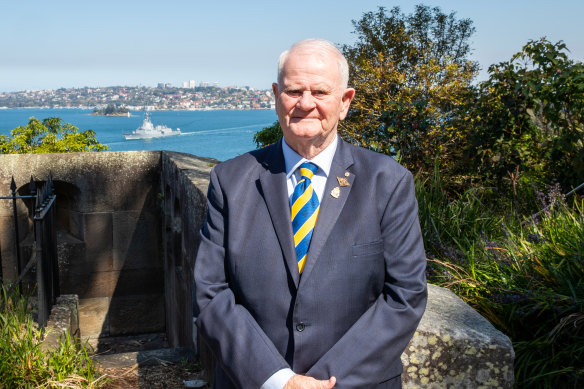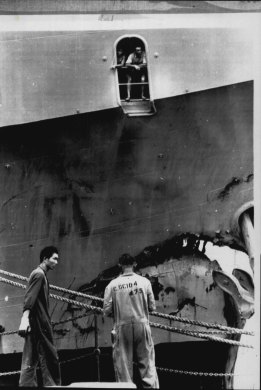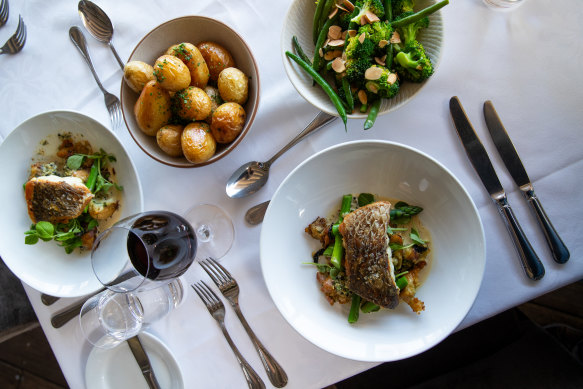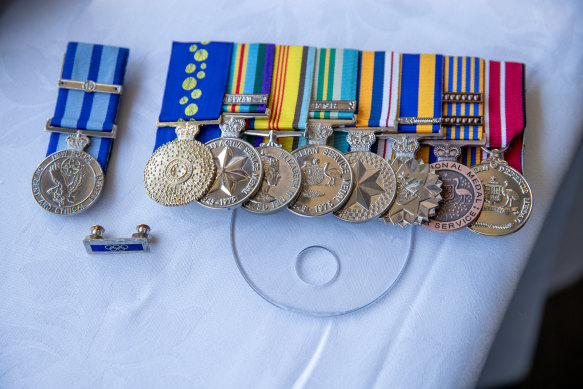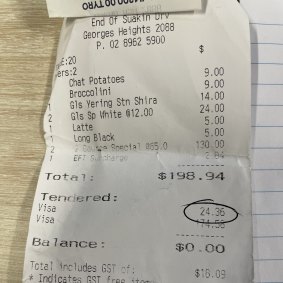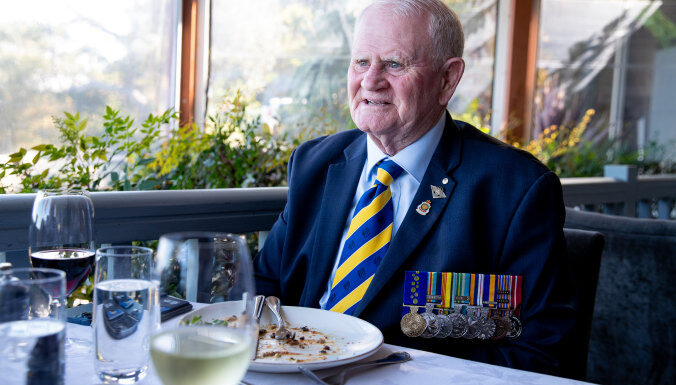
Save articles for later
Add articles to your saved list and come back to them any time.
We are sitting in glorious sunshine at the historic Gunners’ Barracks at Georges Heights, Mosman, constructed in 1873 to protect Sydney Harbour from maritime attack. The view we are enjoying now was 150 years ago a vantage point to artillery gun crews overseeing an “outer line” of defence of the Harbour.
It is an appropriate setting for lunch with Ray James, who has just retired as president of the Returned and Services League (RSL) of NSW. What is about to unfold is a remarkable coincidence. He served on an earlier incarnation of HMAS Brisbane twice serving as a stoker. That ship was scuttled at the end of its service life off the coast of Mudjimba, Sunshine Coast, Queensland, in 2005. But now, coming into view, having just left Garden Island and just before our starters arrive, is the next generation in his family of sailors. HMAS Brisbane (III) a guided missile destroyer deploying to Asia including the South China Sea for three months of exercises.
The just retired NSW RSL president Ray James with the HMAS Brisbane (III) on the harbour behind him with his grandson on board heading for the South China Sea.Credit: Edwina Pickles
“My grandson Harry Whalan is on that,” says James. “I was on HMAS Brisbane twice, my last ship as chief petty officer on board. I am very proud that my grandson joined the navy three years ago and his first ship is the new HMAS Brisbane.”
In 1968 James served on HMAS Melbourne, which had just undergone a 12-month refit. “Then we went ‘up top’ and ran over the Evans [a Sumner-class destroyer]. We collided with the USS Frank E Evans and killed 74 Americans, third of June ’69 at 3.15 in the morning.
“I still remember that like it was yesterday. We were turning into the wind to launch aircraft. The Evans cut across our bow. Their captain was actually asleep at the time and a junior officer took charge. When it hit, I was going on watch at ten to four anyway, there was a big shudder. It [the Evans] went down within a couple of minutes. From the 74 only one body was recovered.” Four officers (the captains of Melbourne and Evans, and the two junior officers in control of Evans at the time of the collision) were court-martialled. (The captain of the Melbourne was honourably acquitted and, in 2012, the federal government apologised to the captain of HMAS Melbourne for being made a scapegoat for the disaster.)
Crippled HMAS Melbourne at Sembawang shipyard, June, 1969.Credit: UPI Radiophoto
The stories with dates come thick and fast. Service in the forces pervade James’s family. He was only 16 when he joined HMAS Sydney, turned 17 in March 1971 and sailed for Vietnam in April.
As the HMAS Brisbane (III) disappears from view the conversation returns to Garden Island. “There were tunnels there where we stored asbestos to relag the ship’s pipes and boilers,” he explains. “I was with the ‘lagging party ashore’. The area in the tunnel was the lagger’s tunnel, we had our dartboard in there and a bit of social stuff. We breathed it. I have got a pleural plaque on my lungs, it’s not asbestosis, but it turns to asbestosis sometimes.
“I’ve just done RSL services for two of my mates, one that joined the navy with me that died of asbestosis. The RSL looks after the widows, and we look after their husbands before they pass. There’s still claims going on. We all lived among that stuff on those older vessels, the cabins had asbestos for insulation. Asbestosis was rife throughout the RAN in those early days. There would be some widows that haven’t been paid out, they don’t know where to go or what do but the RSL is in that space.
“On the [HMAS] Sydney when I was doing the Vietnam runs I was in the boxing team, and we used to train in C hangar. That’s where the movie nights used to be too. There were 44-gallon drums tied up against the bulkhead, they were always leaking. We later found out that they were full of Agent Orange. We were taking it up to Vietnam as a defoliant. Some people are still claiming in relation to that today.”
NSW RSL president Ray James. Credit: Edwina Pickles
We are dining in the Gunners’ Barracks, which now serves lunches and high teas. We order starters of vanilla and tea smoked salmon and James has pressed lamb shoulder with cauliflower puree. To follow we both opt for roasted barramundi with crushed roast chat potatoes and warm tartare sauce buttered asparagus.
A glass of Shiraz arrives. “I’ve never drank a bad red yet,” James says. “I drank one bad beer in all my time around the world and that was a glass of Three Coins in Ceylon [now Sri Lanka]. To start with it was hot, they’d run out of cold beer because the Aussies were in town. They put a handful of ice in it, but it was the worst beer I’ve ever tasted. I’ve still got the taste in my mouth now.”
After the navy came service with NSW Police. He helped train 480 officers in bomb search techniques and the protection of the athletes’ village ahead of the Sydney Olympics in 2000.
He joined the RSL in 1975 at the Marrickville sub-branch, one of the few at the time that would take Vietnam veterans. (Ray James apologised on Vietnam Veterans Day in August on behalf of the RSL for the hostile reception that some returning veterans received.)
There still persists an issue that the RSL has struggled to clarify in the public’s mind for many years. “In those days the RSL sub-branches and the clubs were one and the same,” he explains. “That didn’t change until the late 70s when the clubs had to split because liquor and gaming licences could not be held by a charity in NSW. Now the clubs and sub-branches are two separate entities.
Lunch at the Gunners Barracks.Credit: Edwina Pickles
“It still confuses people today and that’s a shame because we are not [running the] poker machines and all that sort of stuff, and that’s why a lot of younger veterans are not coming to the League.
James became acting president in 2019 and was elected in 2020 for a three-year term that finished last month. He came to the job at a time an embarrassing issue was going through the courts. A former RSL NSW president Don Rowe was ordered in April 2020 to pay a $2000 fine and be of good behaviour for two years after using one of the charity’s credit cards to pay $9400 in hotel and phone bills for family members.
Rowe, then 71, and a Vietnam veteran, was found guilty in February that year of two counts of dishonestly obtaining financial advantage by deception. But in August, the fraud conviction was quashed after a judge ruled he had lawfully submitted expenses for phone bills and a hotel stay.
“The problem with the League at the time was poor governance and compliance and conflicts of interest,” James said. “When the League changed direction and a club couldn’t have a gaming and liquor licence, most of the people who were executive members of the sub-branches were also board members of the clubs and that kept eroding the League going forward, they couldn’t manage those conflicts of interest.”
James’s RAN service medals and NSW Police medal.Credit: Edwina Pickles
But the same person can still be on the board of the club and the sub-branch. Does that worry him? “Yes, it does worry me because the conflict of interest is hard to manage.”
But he’s upbeat about the future. “Now, for the first time in four decades, we have increased our membership by 11 per cent. Eighteen months ago, the average age of our membership [total 27,000] was 78 but since then, we have recruited 7,000 new members and the average age of those new members is 51. We are out there telling people who we are and what we do. We look after veterans and their families. Our forefathers started this in 1916-17, and it was for their mates, and that’s what we should still be doing today.
“Some 2,000 women have joined the RSL since 2019, which is a good thing. The Australian Defence Force is changing but so is the RSL. The RSL was like a men’s club. It was male dominated, even women in the 70s and 80s couldn’t join, even if they had served. They had to join what was called the Women’s Auxillary. A big percentage of the crew on ships like the one my grandson is serving on are females. When you see a ship coming home, instead of just wives with their kids, you have got male members waiting for their loved ones to come back.”
The bill.
Also changing is the way the RSL in NSW wants to manage its finances under its Strategic Plan 2021-2026 which is proving to be a hard sell to some of the wealthiest sub-branches. It says it makes sense to combine financial resources to achieve greater impact on veterans’ wellbeing, such as donations to its partner charity, veteran services provider RSL LifeCare.
The plan states: “The future for RSL NSW is in re-establishing what it stands for. We have a serious and urgent purpose, but that purpose is underfunded.”
James adds: “We have got $750 million in sub-branch assets in NSW. Some of our sub-branches have got $30 million bucks and some of them have got $5. We urge our sub-branches to collectively invest in delivering our charitable purpose so that no veteran or their family is unsupported.
“RSL NSW has established a way for sub-branches to consider other investment opportunities for the longer term which should provide greater funding for the delivery of services and support to veterans and their families.”
“The RSL has been around a long time,” James says. “Yes, it has hit rocky roads a few times, but we are there for the main thing and that is looking after veterans and their families. We are slowly changing, we are slowly getting younger people coming in and taking executive positions.” James’s replacement is Mick Bainbridge, a former Special Forces commando, and the youngest president ever elected.
“I’m leaving feeling comfortable about where we have got to. I want to see my grandson in the league as a president one day. It is the most noticeable and best known ex-service organisation in Australia.”
Start the day with a summary of the day’s most important and interesting stories, analysis and insights. Sign up for our Morning Edition newsletter.
Most Viewed in National
From our partners
Source: Read Full Article
